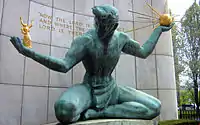Verdigris
Verdigris is the common name for a green pigment obtained through the application of acetic acid to copper plates[2] or the natural patina formed when copper, brass or bronze is weathered and exposed to air or seawater over time. It is usually a basic copper carbonate (Cu
2CO
3(OH)2), but near the sea will be a basic copper chloride (Cu2(OH)3Cl).[3] If acetic acid is present at the time of weathering, it may consist of copper(II) acetate.

| Verdigris | |
|---|---|
| Hex triplet | #43B3AE |
| HSV (h, s, v) | (177°, 63%, 70%) |
| sRGBB (r, g, b) | (67, 179, 174) |
| Source | Encycolorpedia [1] |
| ISCC–NBS descriptor | Brilliant bluish green |
| B: Normalized to [0–255] (byte) H: Normalized to [0–100] (hundred) | |
Etymology
| Look up verdigris in Wiktionary, the free dictionary. |
The name verdigris comes from the Middle English vertegrez, from the Old French verte grez, an alteration of vert-de-Grèce ("green of Greece"). The modern French spelling of this word is vert-de-gris ("green of grey"). It was used as a pigment in paintings and other art objects (as green color), mostly imported from Greece.[4]
Manufacture
It was originally made by hanging copper plates over hot vinegar in a sealed pot until a green crust formed on the copper.[4] Another method of obtaining verdigris pigment, used in the Middle Ages, was to attach copper strips to a wooden block with acetic acid, then bury the sealed block in dung. A few weeks later the pot was dug up and the verdigris scraped off. In eighteenth-century Montpellier, France, it was manufactured in household cellars, "where copper plates were stacked in clay pots filled with distilled wine." The verdigris was scraped off weekly by the women of the household.[5]
The chemical reaction exhibited between wine and copper to produce verdigris may be related to wine's own oxidation process. Another method, used in the early nineteenth century, had to do with reacting copper sulfate solution with solutions of lead, barium, or calcium acetate. Their sulfates are insoluble, forming precipitates and leaving the copper acetate in solution.
Uses
Natural or artificially created coatings of verdigris are commonly used as a patina to protect copper or bronze objects, especially in architecture.
It is also used industrially as a fungicide, a catalyst for organic reactions, and in dyeing (The Merck Index , Ninth Ed., 1976). Verdigris has also been used in medicine.[6]
Pigment


The vivid green color of copper(II) acetate made this form of verdigris a much used pigment. Until the 19th century, verdigris was the most vibrant green pigment available and was frequently used in painting.[7][8] Verdigris is lightfast in oil paint, as numerous examples of 15th-century paintings show. However, its lightfastness and air resistance are very low in other media. Copper resinate, made from verdigris by boiling it in a resin, is not lightfast, even in oil paint. In the presence of light and air, green copper resinate becomes stable brown copper oxide.[4]
This degradation is to blame for the brown or bronze color of grass or foliage in many old paintings, although not typically those of the Early Netherlandish painters such as Jan van Eyck, who often used normal verdigris. In addition, verdigris is a fickle pigment requiring special preparation of paint, careful layered application and immediate sealing with varnish to avoid rapid discoloration (but not in the case of oil paint).[4] Verdigris has the curious property in oil painting that it is initially bluish-green, but turns a rich foliage green over the course of about a month. This green is stable.
Verdigris fell out of use by artists as more stable green pigments became available.
Chemical properties
Copper(II) acetate is soluble in alcohol and water and slightly soluble in ether and glycerol. It melts at 115 °C (239 °F) and decomposes at 240 °C (464 °F). It can be prepared by reacting copper(II) oxide, CuO, or copper(II) carbonate, CuCO3, with acetic acid, CH3COOH.
Verdigris is a variable chemical mixture of compounds, complexes and water. The primary components are copper salts of acetate, carbonate, chloride, formate, hydroxide and sulfate. The secondary components are other metallic salts, acids (organic and mineral), atmospheric gases and water. All the components are in an ever-changing and complex electrochemical reaction equilibrium that is dependent on the ambient environment.
See also
- Bronze disease
- List of colors
- List of inorganic pigments
- Patina
References
- Encycolorpedia page on veridgris
- "Verdigris" Oxford English Dictionary
- Sharp, D. W. A: "Penguin Dictionary of Chemistry", page 419. Penguin Books, 1990 (2nd edition)
- St. Clair, Kassia (2016). The Secret Lives of Colour. London: John Murray. p. 215. ISBN 9781473630819. OCLC 936144129.
- Darnton, Robert. "A Bourgeois Puts His World in Order" in The Great Cat Massacre --and other Episodes in French Cultural History. New York: Vintage Books, 1985. p. 114.
- "Medical Uses of Copper in Antiquity". Copper Development Association. Retrieved 8 June 2014.
- H. Kühn, Verdigris and Copper Resinate, in Artists’ Pigments. A Handbook of Their History and Characteristics, Vol. 2: A. Roy (Ed.) Oxford University Press 1993, p. 131 – 158
- Verdigris, ColourLex
External links
- National Pollutant Inventory - Copper and compounds fact sheet
- Verdigris, ColourLex
- Making Pigments - Verdigris, Paul Grosse
